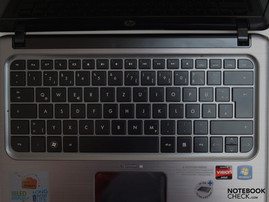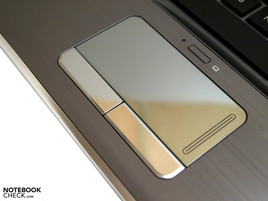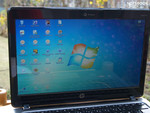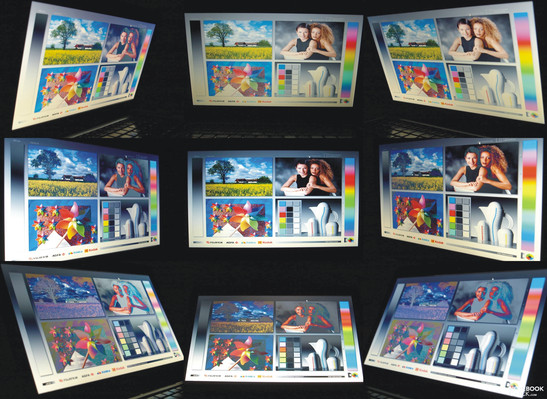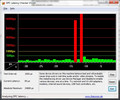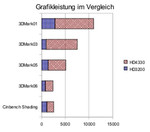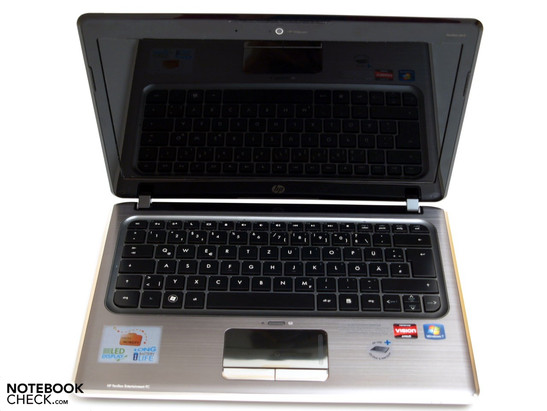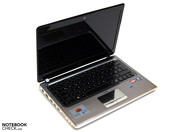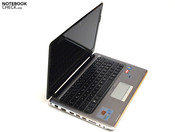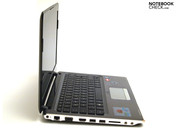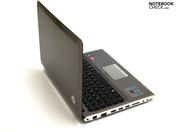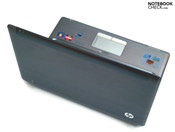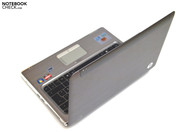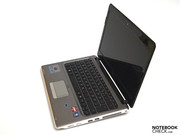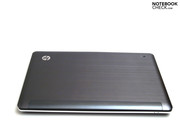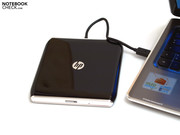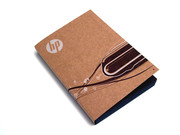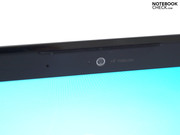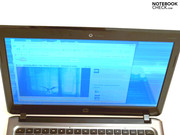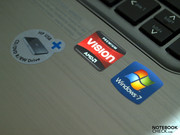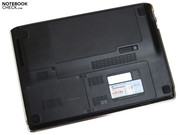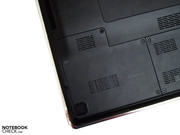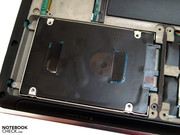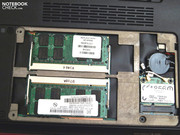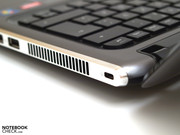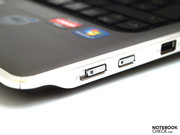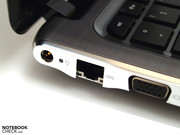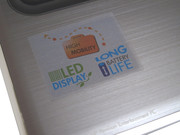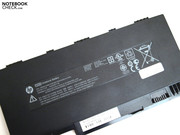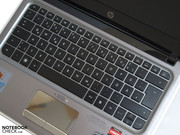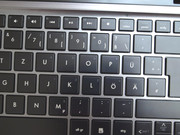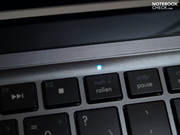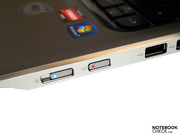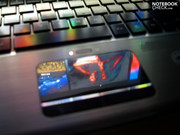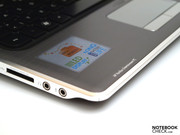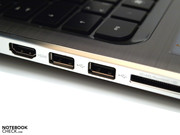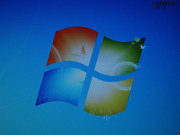Review HP Pavilion dm3-1010eg laptop
Pure Subnotebook Entertainment With a Graphics Boost
HP is releasing the Pavilion dm3, a subnotebook for consumers, which should score points with its multimedia functionality and hybrid graphics. In this review, we will show you what the dm3 is really capable of and whether it lives up to HP's claims of the dm3 being a "light-weight" laptop with "heavy-weight" performance and up to 10 hours of battery life.
The HP Pavilion dm3-1000 entertainment notebook series offers a variety of models specific to different countries. The series includes models based on both the AMD platform, such as our test model, and the Intel platform. These models have either the Intel GMA 4500 MHD graphics chip or the Nvidia Geforce G105M graphics card. In Germany, these models currently have either the Intel Pentium SU4100 or the Intel Core 2 Duo SU7300 processors.
In the United Kingdom, one of the CPUs used for the Intel-based platform is the Intel Celeron SU2300. The US model dm3-1040us, on the other hand, is equipped with the Intel Pentium SU4100, but has an integrated GMA 4500M HD graphics chip. In the review we had the dm3-1010eg (VJ392EA), which has an AMD M780 chipset, hybrid graphics with an integrated ATI Radeon HD3200 and an ATI Mobility Radeon HD4330 graphics chip, the AMD Athlon Neo X2 Dual-Core-CPU L335, and 4 gigabytes of RAM. Results dependent on performance-bearing components are only transferable to other models with limitations.
Case
The HP Pavilion dm3 has an ultra-thin case which is only 326 millimetres wide, 230 millimetres long and has a maximum thickness of 31.8 millimetres. The total weight of the case comes to roughly 2 kilograms. The case has been designed so that the height of the laptop slowly increases as you go further back, so as to allow for a better typing feel.
The laptop description on the manufacturer's site says that the colour of the product is a "brushed aluminium". However, the buyer should know that the laptop is not made of entirely aluminium. On the bottom, the display case, the hinges, and their counterparts on the base are made of black plastic and, except for the bottom, are all high-gloss. The touchpad also has a high-gloss metallic surface. As usual, it is very easy to dirty the high-gloss parts with fingerprints and smudges, so it is very hard for us to understand why the manufacturer would make surfaces which are often touched high-gloss, like that of the touchpad. Apart from that, the surface of the touchpad has other disadvantages as well; however we will go into further detail about that later on in the review.
The feel of the wrist-rest regions, which are made of aluminium, is definitely not to be criticized. However, the right side of the base unit bends slightly under pressure and makes a clicking noise. Besides that the case of the laptop is sturdy and the distortion-resistance of the hinges is excellent. However, the different offsets between the upper side and the side parts, and between the lateral edges in the front corner areas didn't turn out so well. In some places the metallic glossed lateral edge has too much play and can be slightly moved against the case. Likewise the battery doesn't quite sit firmly enough in the case.
The very light display lid gives a little when picking up from a corner under the acting forces, whereby after putting the system down you can sometimes notice a cracking. Here too, the change from aluminium component to plastic isn't optimal. Pressure against the display borders can cause picture distortion on a powered-on display, and for the same reason as above, you can also notice cracks in places.
The small angled hinges fixed on the side of the display limit the maximum opening angle to around 130 degrees. One-handed adjustment of the opening angle is not possible. All the while, the display clearly see-saws after adjusting the opening angle. Therefore in juddery work environments, like during a train journey, you would have to deal with vibrating of the display. When going under a certain minimum angle of the display, the notebook is automatically closed. As there's no transport lock and the notebook opens to thumb-width when kept upside down, you should be careful that no foreign objects enter between the keyboard and the delicate display when travelling.
Connectivity
HP has equipped the Pavilion dm3 with all interfaces that you would expect from a reasonable entertainer. Alongside VGA for analogue connection to a monitor or projector, the dm3 also has an HDMI connection for digital image and audio transfer. With the built-in 5-in-1 card reader, which supports SD, MMC, MS, MS-Pro, and xD cards, you can read and write many popular card formats and hopefully that of your own digital camera. Worth stressing is the fact that in a small 13.3-incher there's four USB-2.0 interfaces. All the while you'll have to do without an internal optical drive. HP has, however, made up for this and provides an external USB drive, which nevertheless features a very short and permanently fixed connection cable. For this reason, nothing gets in the way of enjoyment of a DVD film.
The interfaces distribute themselves along the left and right sides. For left-handed people the video interfaces, HDMI und VGA, might not be placed optimally in the middle area of the left side. On the left and right there are also two USB 2.0 ports in the middle region. As long as you use only two of them, you at least have the chance to keep your favourite side free. Due to the narrow leading edge the audio interfaces are also on the sides. For this purpose HP has chosen the left side. Due to the opening mechanism no interfaces could be put on the rear either. Overall there's a reasonably well thought-out arrangement of interfaces nevertheless.
Network access on the Pavilion dm3 is provided by two modules. For cable connections there's the Realtek RTL8139/810x Fast Ethernet Adapter, for wireless connections there's the Atheros AR9285 802.11b/g/n WiFi Adapter. In the test model there was no Bluetooth. An integrated broadband modem (UMTS) isn't currently destined for any models. UMTS could nevertheless be retrofitted via an USB modem, whereby two USB ports are often used. The HP webcam features an integrated digital microphone, so VoIP should be no problem.
Windows 7 Home Premium 64-Bit was pre-installed on our test device. Recovery media or drivers can be searched for in vain in the box. Therefore it's advisable to burn a recovery DVD with the pre-installed tool straight after the first boot-up. In addition you can recover the HP dm3 via the hidden partition.
As standard HP offers two years of pick up and drop off service, whereby the manufacturer's guarantee covers replacement parts and labour. The HP 'Care Pack' can extend the guarantee up to three years with accidental damage cover, at a costly 240.- Euro surcharge.
Input devices
Keyboard
The keyboard with individual keys pleases with its standard layout and big keys at 15 mm wide with generous space between keys. On the lowest row, the keys are moulded to be wider. In return the up and down arrow keys share height. We've rather gotten used to the absolutely flat key tops with rather flush plastic surfaces.
You can be pleased with the mechanical qualities of the keys, the relative long stroke distance and clear feedback, and the rather quiet sound when in use. Controlling important functions, like adjusting the display brightness and the multimedia functions, are chosen as primary key functions of the Fn keys, whereby the individual F-function is accessible via the Fn-key combination. It's quite simply a practical decision, as you use the actual F-functions rather less often compared to brightness adjustment, volume and co. Apart from a hardware WLAN switch on the right side, HP has totally done without possible special keys. The status indicators for activated caps lock, num lock, mute, touchpad and WLAN are made very well. The corresponding LEDs are found directly alongside the relevant keys or respectively directly by or on the switches.
Touchpad
The touchpad is oddly finished in a metallic, glossy, flush surface. With the clearly noticeable but nevertheless curved transition to the circumfluent, brushed, matte aluminium, it differentiates itself in terms of touch rather well. Indeed the flush touchpad surface is not only good to the touch, but it also allows precise navigation under all circumstances. As long as your fingers aren't bone dry, the gliding qualities aren't so good. That said, the touchpad works flawlessly and alongside the visually marked vertical scroll region features several multi-touch gestures. Should you choose not to use the touchpad, you can turn it off via one of the buttons along the top.
The appropriate buttons are likewise finished in a high-gloss metallic look. The pressure resistance is relatively high, the stroke distance is short and the noise when used offers a clear but not excessively loud feedback.
Display
When it comes to the display, there's an AUO102C with LED background illumination from the Taiwanese manufacturer AU Optronics Corporation. The 13.3-inch BrightView widescreen display, thus reflective display, offers a cinema-friendly 1366x768 resolution in the 16:9 format.
| |||||||||||||||||||||||||
Brightness Distribution: 85 %
Contrast: 170:1 (Black: 1.16 cd/m²)
At most the brightness adds up to 201 cd/m², measured in the left upper segment, and gradually declines to the right and below, so that we measured a minimum brightness of 176.8 cd/m² for the right lower corner. For this reason there's still a rather good illumination of almost 88%. With the relatively high black level of 1.16 cd/m² and the maximum brightness of 197 cd/m² measured in the central segment, the laptop reaches a satisfactory contrast ratio of 1:170. Subjectively, the colours are quite good. Likewise you can see no irregularities in the presentation of monochromatic images.
Now on to the biggest disadvantage of the display. Due to its reflective surface, you can notice reflections of your environment, strengthened by the reflective display borders. These are visible even indoors in unfavourable light conditions. For this reason the device just isn't suited for professional long-term use, yet the device admittedly isn't designed to these ends. Outdoors in daylight, the mirror effect clearly arises, even in shadows. We had to do without a test under direct sunlight due to weather conditions - however you can probably guess the result.
The viewing angle stability also isn't one of the strengths of the Pavilion dm3. To some degree we have already become used to the fact that the available stable workspace in the vertical dimension so often turns out to be so narrow. Horizontally the dm3 performs averagely compared to comparable devices. Indeed the workspace is bigger horizontally than vertically, yet when reducing the angle, more reflections and colour changes arise.
Performance
Our Pavilion dm3 test device is based on a M780 chipset from AMD (-> manufacturer link) and is equipped with an AMD Athlon Neo X2 L335 Dual-Core processor with a clock speed of 1600 Mhz. Therefore we're dealing with a dual-core processor manufactured in the 65 nanometre process with a maximum of 256 Kilobytes of Level 2 cache and a thermal design power of 18 Watt. The M780 chipset supports up to 8 GB RAM. Its ATI PowerXpress technology allows the user to switch between the integrated graphics chip, an ATI Radeon HD 3200, and an external graphics card. Our test device makes use of this possibility and has an ATI Mobility Radeon HD 4330 on board.
Furthermore there was 4 Gigabytes of RAM in the test device, in the form of two 2 GB modules. Should you want to upgrade, you would have to remove at least one of the two chips. You should be unconcerned about the support of the RAM by the operating system. The pre-installed Windows 7 Home Premium 64-Bit can utilize more than four gigabytes problem-free. Overall, according to the system information, the overall memory available is 3.75 GB. Therefore this is clearly more than with a 32-Bit operating system.
The processor performance is comparable to a Pentium Dual Core SU4100 or a Core 2 Duo L7100 from competing Intel. In addition, in terms of performance the CPU is lukewarm among the Intel Core 2 Duo SU9300 and SU9400 CPUs, which are constantly to be found in devices with a low form factor, with a clearly lower TDP of 10 Watt.
Unfortunately the processor performance decreases in battery use. In the Cinebench multi-rendering test, for example, performance fell by 6%. The cause of this could be the fluctuating clock speeds in battery use, whereby the clock speed also consistently falls to 800 MHz with a small amount of load.
| PCMark Vantage Result | 2739 points | |
Help | ||
The application performance of the Pavilion dm3 corresponds to our expectations and is in the middle of the table, compared to similarly equipped devices. Thus the PCMark Vantage values remain on the same scale as the Acer TravelMate 8371 (13.3-inch, SU9400, Intel GMA 4500M HD, 4GB RAM) or the Asus UL30A-QX050V (13.3-inch, SU7300, Intel GMA 4500M HD, 4GB RAM).
| 3DMark 2001SE Standard | 10993 points | |
| 3DMark 03 Standard | 7507 points | |
| 3DMark 05 Standard | 5078 points | |
| 3DMark 06 Standard Score | 2357 points | |
Help | ||
As for hard disk the Pavilion dm3 offers a ST9320423AS hard disk from Seagate. This offers 320 GB net capacity and works at a speed of 7200 rpm. Regarding the HDTune benchmark values, there were no surprises compared to similar 7200 rpm disks. That is, apart from a negative CPU load of -1.0%!
The activated graphics solution chosen decides the graphics performance. On the one hand there's the on-board ATI Radeon HD 3200. This supports Direct X 10 and integrates its own video decoder called UVD, which supports the CPU when decoding HD videos (MPEG-2, H.264, VC-1).
With ATI Mobility Radeon HD 4330 graphics chosen the graphics performance is increased considerably, yet the device still doesn't break free from the multi-media entry-level. Video and photo editing are no problem depending on demands. It gets a little tight with 3D intensive applications, like modern computer games. For this reason we have left out intensive game tests and refer to our game list.
The comparison between activated and deactivated HD 4330 is interesting. Depending on application, there are performance increases of 123% up to 290%. The 3DMark03 test provided a strikingly low result with the internal HD3200 graphics chip and is just mentioned for the sake of completeness. The detailed result is found in the adjacent graph. Only with the activated HD4330 the advantage of the HP Pavilion dm3 test device is shown, compared to the aforementioned notebooks with Intel 4500M HD graphics. Whilst the graphics performance with the HD3200 is on the same scale, it can clearly break away from it with HD4330 active.
Emissions
System Noise
Whilst the system noise remains in limits in use with low load at 35.1 dB(A), the notebook is considerably louder at 42.7 dB(A) under load. On average there's a moderate 36.6 dB(A). The access noise of the hard disk is between the minimum value and the average level at 35.8 dB(A). The maximum system noise is put in to perspective, since permanent full load doesn't really form part of the device's intended use.
Noise level
| Idle |
| 35.1 / 0 / 0 dB(A) |
| HDD |
| 35.8 dB(A) |
| Load |
| 36.6 / 42.7 dB(A) |
 | ||
30 dB silent 40 dB(A) audible 50 dB(A) loud |
||
min: | ||
Temperatures
From a subjective point of view you could say that the device can get rather hot. This is most noticeable in the region of the left wrist-rest. Whilst the objectively warmest region is in the middle of the keyboard, you might consider this cooler due to this area being free from metal; instead it is made from plastic. Almost 39 degrees Celsius on the left wrist-rest and a peak value of 39.7 degrees Celsius after an hour's stress test are actually pretty hefty figures. It gets worse on the underside with a maximum of 45.8 degrees Celsius. For this reason use of the laptop on the thighs is not advisable, at least with a large load of the device.
When idle with maximum energy-saving options after two hours of use the temperature climb is within limits. At 37.6 degrees Celsius on the underside, body temperature is all the while exceeded. Also it should be mentioned that for this the performance-oriented HD 4330 graphics have to be turned off.
(+) The maximum temperature on the upper side is 39.7 °C / 103 F, compared to the average of 35.9 °C / 97 F, ranging from 21.4 to 59 °C for the class Subnotebook.
(-) The bottom heats up to a maximum of 45.8 °C / 114 F, compared to the average of 39.3 °C / 103 F
(±) In idle usage, the average temperature for the upper side is 32.5 °C / 91 F, compared to the device average of 30.8 °C / 87 F.
(±) The palmrests and touchpad can get very hot to the touch with a maximum of 38.8 °C / 101.8 F.
(-) The average temperature of the palmrest area of similar devices was 28.2 °C / 82.8 F (-10.6 °C / -19 F).
Loudspeakers
The loudspeakers from Altec Lansing, situated along the underside on the leading edge, offer pleasing sound, which remains undistorted and clear at maximum volume. The maximum volume is ok for watching films in rooms of up to medium size, for example. Indeed the device does without a subwoofer, yet the range of tones is balanced, on the whole. Connecting headphones via the 3.5 mm audio jack leads to barely any sound improvement.
Battery Life
With the 6-cell lithium ion battery with 57 Wh, good battery life is possible depending on demands and settings. Indeed we didn't reach the 10 hours that's advertised for the US dm3-1040us model. To be fair it should be mentioned that HP states a maximum of 7 hours for this device. At most we reached almost six and a half hours with maximum energy-saving mechanisms, deactivated WLAN, minimum display brightness and HD 3200 graphics with the Reader's Test of BatteryEater Tools. The minimum battery life, which was recorded by the Classic Test of Battery Eater Tools, was just one and a half hours in use under full load, with activated WLAN, maximum brightness and active HD 4330 graphics card. In the practical tests we got almost three hours interruption-free WLAN surfing with maximum brightness, energy-saving profile and HD3200. Watching a DVD with the supplied external drive, high-performance profile, maximum brightness and HD 4330 graphics, the battery was emptied after slightly longer than one and three quarter hours.
In idle mode you can reach a considerable improvement of the battery life by choosing the internal graphics chip. The improvement is around 40 minutes (so around 10%) compared to use with of the HD 4330 graphics. Even under low load choosing the more performance-oriented graphics card does not pay dividends. Under full load you simply save at most around 11 minutes, which is 11%.
Energy consumption in comparison, green?
| Off / Standby | |
| Idle | |
| Load |
|
Key:
min: | |
Verdict
The test model at hand performs quite well, conforming to the demands of a small, mobile entertainer, on the whole. The switcheable graphics on demand is good for momentarily adjusting graphics performance and battery life. All the while, no new peak values are reached when it comes to battery life with a maximum of 6.5 hours.
The strongly reflective display proves to be a stumbling block to the device's mobile aspirations. Also, the brightness could be a smidgen higher for outdoor use.
Despite the relatively small format the range of interfaces is very well suited to the planned realms of use. With HDMI, webcam, four USB-2.0 connections, LAN and Bluetooth you'll find almost everything that you could wish for in a mobile entertainer. It's only the internal optical drive that's lacking. However, HP has made up for this and provides an external USB drive.
The dm3 was developed as a mobile entertainer for the consumer market - professional long-term use is not advisable due to the reflective display. Should you consider the dm3 more closely, you should be careful of the specific, very different specification of individual models, which ultimately determines the laptop's area of use.









